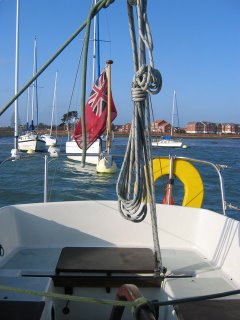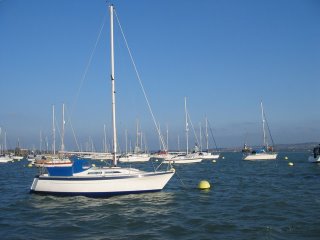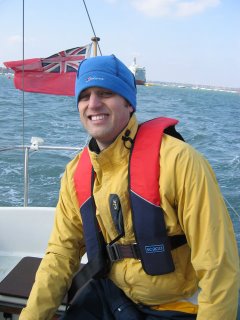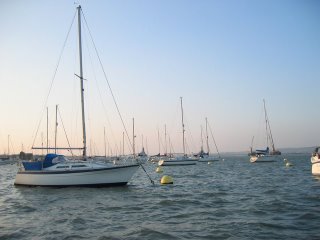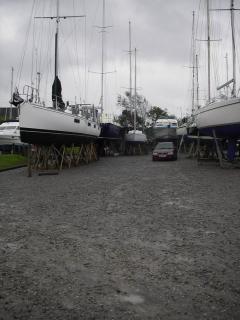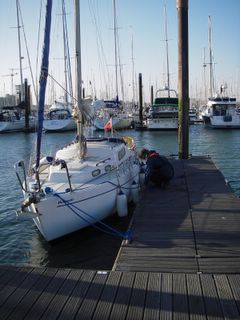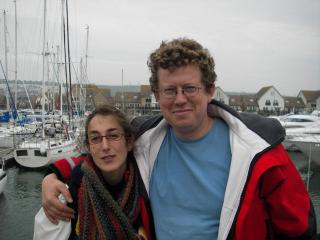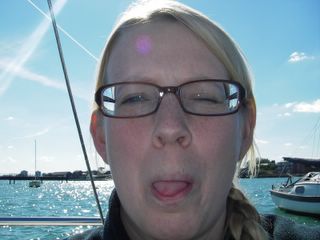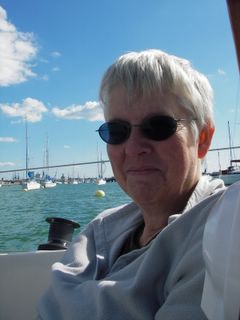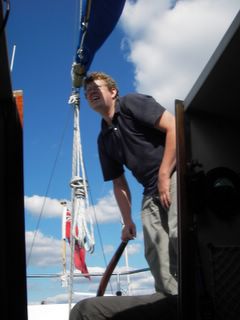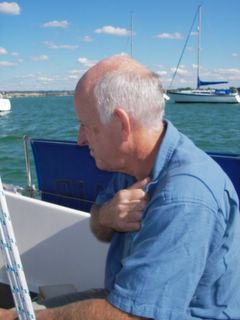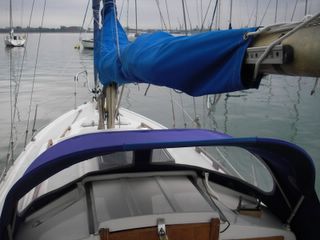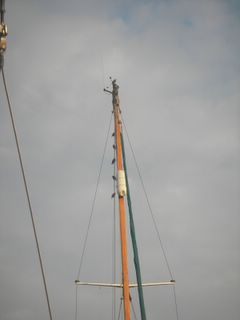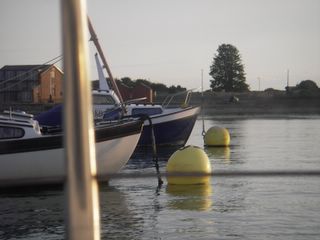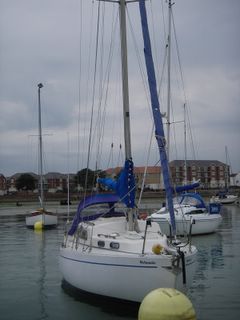The trip from Portsmouth to the Medway, previously described as a giant leap, was really no more than a couple of small steps, although we did manage to trip up and graze our knees.
Debonair and her crew were quivering with excitement (or maybe the cold) at the start of the first 'real' sailing trip. We left at noon, the boat laden down with jaffa cakes and other essentials, and I realised that Debonair was now homeless, a ship without a port. We were going on a trip with no real destination in mind. All very Beat generation. Where would we next touch land? Morocco? Delhi? We setted on Chichester Harbour and slipped our Gosport Mooring for the last time.
Chichester harbour was a short trip out of the Solent and we turned up at the anchorage with our office worker faces blasted bright red by the breeze. I went through my rules of twelfth and we anchored in 3metres of muddy water, rowed ashore and went to the pub, ready to relish our new sea salt status, sitting by the fire and launching into tales of terrible sea monsters for the benefit of passing land lubbers. How exciting, this life of salty winds, far away lands and adventure!
Unfortunately, we hadn't reckoned on the other part of sailing trips. The part that involves tide tables, almanacs, 'tidal stands', and GMT/BST. We got back to the beach, singing a shanty to find surprisingly little sea (too much shandy I expect.) Debonair was high and dry, sitting on a mud bank with the mast pointing almost horizontally out towards the increasingly dark and distant water. Our boy scout instinct was instantly engaged, and we waded through the knee deep mud to tie knots and to look busy. Raf got his only chance to admire the keel art, but the schools of fishes looked quite out of place that far out of the water.
It was dark by the time that Debonair floated again, and we were tired and cold. We weighed anchor, and motored around in a bit of a rush, looking for more depth. In the end we found somewhere out of the channel, dropped anchor again, and went to bed. I was worried: how much more water did we need? Short answer: more than we chose. This time we settled at almost exactly the low water mark, Debonair was lying on her side but this time the water didn't recede any further than the keel.
LESSON 1: Be careful when working out the depth to anchor. Look out for BST/GMT confusion and funny tidal stands. Debonair now only works on UK time (i.e. BST).
Suitably red-faced, we floated about an hour before the annoyingly snug guy in the bilge keeler on the beach and headed out of the harbour, destination Brighton. It was windy but the forecast from the previous day had said force 5, so we carried on towards Selsey Bill. There were rocks on the high scale chart I had on board, and I'd developed an aversion to contact between Debonair and land, so we took the offshore route. We sailed close hauled towards the first buoy trying to get round it so we could turn towards Brighton, directly down-wind.
It got windier. We weren't going to get round the buoy on this tack, so we started the engine and I pulled on the reefing line for the jib. Normally, pulling this rope should neatly roll up the front sail, first to make it smaller, and then to completely stop the wind from blowing the boat around. I pulled, and I pulled and the sail moved an inch. I braced my leg against the side of the cockpit, and pulled some more. This time it had an effect and the rope came completely loose. I'd managed to pull the reefing line out of the sail. In the moment before the whole sail unravelled and the boat healed right over on it's side, I said something. I can't remember what, but I have a few possibilities in mind... This was our first 24 hours, and our second mishap. After about 20 minutes of fumbling around on the foredeck, I managed to drop the sail, pull it out of the water, where it was acting as a very effective sea anchor, and lash it to the guard rails and Debonair came back under control. I may have said a few more words, but I can't remember those either.
Now the wind was even stronger and there was a large swell behind us as we turned around the headland towards Brighton. We'd lost sight of land without noticing while sorting out the sail and we didn't see it again until we were a mile or so away from the harbour. Looking back at the waves behind (and above) us we didn't want to try the main sail downwind because I'd removed the reefing lines and forgotten to replace them, and either way a gybe would be dangerous. So we motored and I prayed to the Gloucestershire god Beta marine, and he replied in a thick west country accent. His engine worked exactly when we needed it and we lurched along amongst the large waves.
It was quite hard to keep our course as we surfed at up to 11 knots down the face of the waves. In those six or seven hours, a few waves broke over the back of the boat putting water into the cockpit. I imagined myself in the Southern Ocean swell as I watched it drain away wondering how much was getting through the cockpit floor...
Brighton appeared, then the marina wall, and it got larger. And larger. It is an impressive breakwater, higher than the top of the mast, and concrete. Vaguely remembering hearing about the perils of a lee-shore, I steered down each wave, trying to keep us pointing towards the seemingly tiny entrance at one end of the massive structure. We surfed in through the middle, and turned the corner into the perfect calm of the marina. It was a while before we came down from our state of near panic, and we circled around near the visitors pontoons for about 10 minutes before calling the marina to get a berth (much to their amusement!)
LESSON 2: Check the weather forecast every time it is updated. I use my mobile phone to download the inshore forecast from the met office website. Sailing in Force 6 can be fun, but it's harder to fix things if they go wrong.
LESSION 3: Make sure that the cockpit floor is well attached and well sealed. This is very good for the blood pressure.
LESSION 4: How tired you and the crew are, and your mood, makes a big difference to how you can cope with difficult situations. This trip was made harder by the fact we hadn't had much sleep the night before.
LESSION 5: Make sure you have installed the reefing lines on the main sail. No comment on this one...
So many lessons! Like being back at school. Raf, the crew, had had enough. And to be honest, so had I. Within an hour of tying up we were showered, and on the train back to London. We needed a day off.
Thinking back, the rest of the trip was a lot less exciting, but a lot more fun. After our day of rest, continued on to Eastbourne. Here, I learnt what the section called "passage planning" in my Coastal Skipper course was all about. It took us a couple of hours to get past Beachy Head against the tide, and I decided to study the tidal atlas more closely for the following days. We experienced some extremes of weather that day too. Hot t-shirt weather out of Brighton, and then sleet and snow of Beachy head. Debonair's first snowman was built, and melted 20 minutes later.
LESSON 6: Like George Bush, tides around the UK are either with you or against you. Unlike George Bush they're fairly predictable and sometimes of some use. And they don't go around starting wars either.
At Eastbourne, I spent a long time poring over my collection of expensive looking sailing books. The Debonair/land disagreement ruled out Rye harbour, so we needed to get to Dover or Ramsgate. I did the math and we left at 11pm. This was to be our first night passage, and our longest passage too. Rather boringly, even for this blog, everything went exactly to the plan. We alternated between sailing and motoring, as the wind changed, we caught all our tides and sped along. And the sun came up conveniently an hour before we had to pass the queue of ships coming out of Dover. It was all so good, we continued under sail up to Ramsgate and patted ourselves on the back with a fry-up and a long nap. Metaphorically, of course.
The last day was under motor in a flat calm along the south of the Thames Estuary. Tied up in Chatham marina that evening I felt that I'd achieved something. Yes, I thought, I've circumnavigated Kent.





